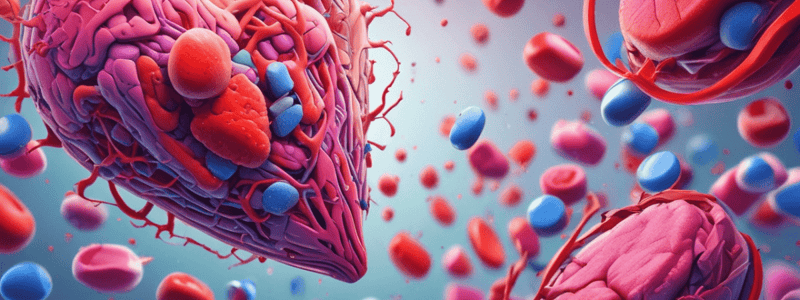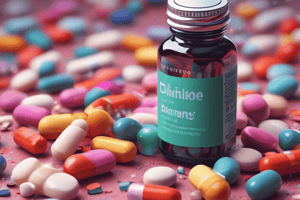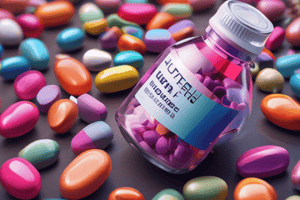Podcast
Questions and Answers
What is the primary mechanism of action of calcium channel blockers?
What is the primary mechanism of action of calcium channel blockers?
- Inhibit the renin-angiotensin-aldosterone system, causing vasodilation
- Prevent calcium from entering cells, especially in the heart and blood vessels (correct)
- Antagonize beta-adrenergic receptors, reducing heart rate and contractility
- Block sodium channels and slow conduction
Which of the following is a common therapeutic use of calcium channel blockers?
Which of the following is a common therapeutic use of calcium channel blockers?
- Treatment of migraines
- Treatment of hypertension (correct)
- Treatment of dysrhythmias
- Treatment of heart failure
Which of the following is a potential adverse effect of calcium channel blockers?
Which of the following is a potential adverse effect of calcium channel blockers?
- Bradycardia
- Anorexia and nausea/vomiting
- Hypotension and reflex tachycardia (correct)
- Constipation
Which calcium channel blocker specifically affects the heart?
Which calcium channel blocker specifically affects the heart?
Which drug class is considered a second-line treatment option compared to calcium channel blockers?
Which drug class is considered a second-line treatment option compared to calcium channel blockers?
What is a unique adverse effect associated with quinidine?
What is a unique adverse effect associated with quinidine?
Which symptom may serve as an early sign of quinidine toxicity?
Which symptom may serve as an early sign of quinidine toxicity?
How does nitroglycerin work in the body to alleviate symptoms of angina pectoris?
How does nitroglycerin work in the body to alleviate symptoms of angina pectoris?
Which population should be cautious with the initial use of anti-dysrhythmic drugs like quinidine?
Which population should be cautious with the initial use of anti-dysrhythmic drugs like quinidine?
What effect does grapefruit juice have on drug metabolism, particularly in interactions with certain medications?
What effect does grapefruit juice have on drug metabolism, particularly in interactions with certain medications?
Which statement best describes the mechanism of action of Angiotensin Receptor Blockers (ARBs)?
Which statement best describes the mechanism of action of Angiotensin Receptor Blockers (ARBs)?
What is a common therapeutic use of Angiotensin Converting Enzyme Inhibitors?
What is a common therapeutic use of Angiotensin Converting Enzyme Inhibitors?
Which adverse effect is associated with Angiotensin Receptor Blockers (ARBs)?
Which adverse effect is associated with Angiotensin Receptor Blockers (ARBs)?
Which condition is specifically targeted with the use of Angiotensin Receptor Blockers (ARBs)?
Which condition is specifically targeted with the use of Angiotensin Receptor Blockers (ARBs)?
What drug interaction consideration is important when starting Angiotensin Receptor Blockers (ARBs) therapy in patients on diuretics?
What drug interaction consideration is important when starting Angiotensin Receptor Blockers (ARBs) therapy in patients on diuretics?
Which of the following is a direct renin inhibitor?
Which of the following is a direct renin inhibitor?
Which of the following adverse effects is more common with non-selective aldosterone antagonists like spironolactone compared to selective aldosterone antagonists like eplerenone?
Which of the following adverse effects is more common with non-selective aldosterone antagonists like spironolactone compared to selective aldosterone antagonists like eplerenone?
Which of the following therapeutic uses is correct for losartan?
Which of the following therapeutic uses is correct for losartan?
Which of the following drug interactions should be considered with ACE inhibitors?
Which of the following drug interactions should be considered with ACE inhibitors?
Which of the following statements about the mechanism of action of ACE inhibitors is correct?
Which of the following statements about the mechanism of action of ACE inhibitors is correct?
What is the primary mechanism of action of calcium channel blockers?
What is the primary mechanism of action of calcium channel blockers?
Which of the following is a common therapeutic use of calcium channel blockers?
Which of the following is a common therapeutic use of calcium channel blockers?
What is a potential adverse effect associated with calcium channel blockers?
What is a potential adverse effect associated with calcium channel blockers?
Which calcium channel blocker specifically affects the heart?
Which calcium channel blocker specifically affects the heart?
Which drug class is considered a second-line treatment option compared to calcium channel blockers?
Which drug class is considered a second-line treatment option compared to calcium channel blockers?
What drug interaction consideration is important when starting Angiotensin Receptor Blockers (ARBs) therapy in patients on diuretics?
What drug interaction consideration is important when starting Angiotensin Receptor Blockers (ARBs) therapy in patients on diuretics?
Which of the following statements about the mechanism of action of ACE inhibitors is correct?
Which of the following statements about the mechanism of action of ACE inhibitors is correct?
What is the primary mechanism of action of direct renin inhibitors like aliskiren?
What is the primary mechanism of action of direct renin inhibitors like aliskiren?
Which of the following is a potential adverse effect of ACE inhibitors that is less common with direct renin inhibitors?
Which of the following is a potential adverse effect of ACE inhibitors that is less common with direct renin inhibitors?
Which of the following is a therapeutic use of the ARB valsartan?
Which of the following is a therapeutic use of the ARB valsartan?
Which of the following drug interactions should be considered when prescribing ACE inhibitors?
Which of the following drug interactions should be considered when prescribing ACE inhibitors?
Which of the following statements about the selective aldosterone antagonist eplerenone is true?
Which of the following statements about the selective aldosterone antagonist eplerenone is true?
Which of the following ARBs is approved for the treatment of diabetic nephropathy?
Which of the following ARBs is approved for the treatment of diabetic nephropathy?
What is a potential concern when abruptly stopping ACE inhibitor therapy?
What is a potential concern when abruptly stopping ACE inhibitor therapy?
What is the primary mechanism of action of Angiotensin Converting Enzyme (ACE) Inhibitors?
What is the primary mechanism of action of Angiotensin Converting Enzyme (ACE) Inhibitors?
Which of the following is a key therapeutic use of Angiotensin Receptor Blockers (ARBs)?
Which of the following is a key therapeutic use of Angiotensin Receptor Blockers (ARBs)?
What is a common adverse effect associated with Angiotensin Converting Enzyme (ACE) Inhibitors?
What is a common adverse effect associated with Angiotensin Converting Enzyme (ACE) Inhibitors?
Which of the following is a unique adverse effect associated with Angiotensin Receptor Blockers (ARBs)?
Which of the following is a unique adverse effect associated with Angiotensin Receptor Blockers (ARBs)?
What is the significance of the '-ipril' and '-artan' syllables in the names of cardiovascular medications?
What is the significance of the '-ipril' and '-artan' syllables in the names of cardiovascular medications?
Which of the following is a potential drug interaction consideration when starting Angiotensin Receptor Blockers (ARBs) in patients already on diuretics?
Which of the following is a potential drug interaction consideration when starting Angiotensin Receptor Blockers (ARBs) in patients already on diuretics?
What is a key therapeutic use of Angiotensin Converting Enzyme (ACE) Inhibitors?
What is a key therapeutic use of Angiotensin Converting Enzyme (ACE) Inhibitors?
Which of the following is a direct renin inhibitor, a newer class of cardiovascular medications?
Which of the following is a direct renin inhibitor, a newer class of cardiovascular medications?
What is a key difference in adverse effects between selective and non-selective aldosterone antagonists?
What is a key difference in adverse effects between selective and non-selective aldosterone antagonists?
Which of the following statements about quinidine is correct?
Which of the following statements about quinidine is correct?
What is the primary mechanism of action of organic nitrates like nitroglycerin?
What is the primary mechanism of action of organic nitrates like nitroglycerin?
Which of the following adverse effects is associated with the use of organic nitrates?
Which of the following adverse effects is associated with the use of organic nitrates?
Which of the following drug interactions is a concern with organic nitrates?
Which of the following drug interactions is a concern with organic nitrates?
Which of the following statements about anti-dysrhythmic drugs is correct?
Which of the following statements about anti-dysrhythmic drugs is correct?
Which of the following adverse effects is associated with quinidine?
Which of the following adverse effects is associated with quinidine?
Which of the following statements about drug interactions with quinidine is correct?
Which of the following statements about drug interactions with quinidine is correct?
Study Notes
Calcium Channel Blockers (CCB)
- Prevent calcium from entering cells, especially in the heart and blood vessels, decreasing heart rate and myocardial contraction.
- Used for hypertension, angina pectoris, and dysrhythmias, maybe migraines.
- Category C.
Cardiac Glycosides
- Inotropic, increasing force of contraction, slowing conduction, and increasing refractory period.
- Used for hypertension, heart failure (HF), and dysrhythmias.
- Reduces symptoms and increases exercise tolerance.
- Adverse effects: headaches, drowsiness, flushing, fatigue, dizziness, and edema.
Vasodilators
- Hydralazine: used for high blood pressure, heart failure, and hypertensive emergency.
- Minoxidil: used for severe hypertension, but with potential serious side effects.
- Nitroprusside: used for hypertensive emergency, acts fast.
Renin-Angiotensin-Aldosterone System (RAAS)
- Angiotensin Converting Enzyme (ACE) Inhibitors
- Mechanism: reduces levels of angiotensin II, dilates blood vessels, increases levels of bradykinins.
- Uses: hypertension, heart failure, myocardial infarction (MI), and nephropathy.
- Adverse effects: cough, angioedema, and hyperkalemia.
- Angiotensin Receptor Blockers (ARBs)
- Mechanism: blocks access to receptors in blood vessels, reducing levels of angiotensin II.
- Uses: hypertension, heart failure, myocardial infarction (MI), and nephropathy.
- Adverse effects: cough, angioedema, and hyperkalemia (less common).
Direct Renin Inhibitors
- Aliskiren: inhibits the conversion of angiotensinogen into angiotensin I, suppressing the entire RAAS.
- Used for hypertension.
Aldosterone Antagonists
- Eplerenone: selective aldosterone receptor blocker, used for hypertension and heart failure.
Anti-Dysrhythmics
- Several categories: sodium channel blockers, beta blockers, potassium channel blockers, calcium channel blockers, and others.
- Uses: dysrhythmias, changing EKG.
- Adverse effects: anorexia, nausea, vomiting, diplopia, and dysrhythmias.
Organic Nitrates
- Used for angina pectoris, reducing oxygen demand by dilating veins.
- Adverse effects: headache, orthostatic hypotension, and reflex tachycardia.
- Nitroglycerin: used for angina pectoris, available in various routes and durations.
Studying That Suits You
Use AI to generate personalized quizzes and flashcards to suit your learning preferences.
Related Documents
Description
Test your knowledge on the adverse effects, drug interactions, and unique characteristics of quinidine. Topics include CNS and GI effects, drug interactions with grapefruit juice, lupus-like syndrome, and first-line use in the African American population.




